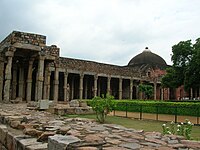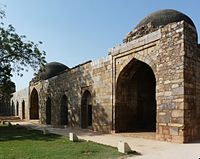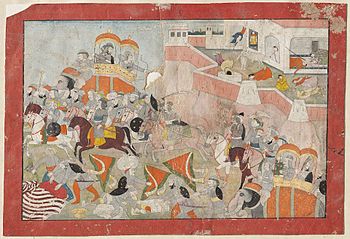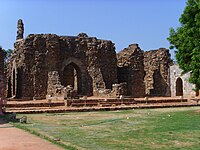Alauddin Khalji
This article has multiple issues. Please help improve it or discuss these issues on the talk page. (Learn how and when to remove these messages)
|
| Ala-ud-din Khilji | |
|---|---|
| Sultan of India | |
 Sultan Alauddin Khilji | |
| Reign | 1296–1316 |
| Coronation | 1296, Delhi |
| Predecessor | Jalal ud din Firuz Khilji |
| Successor | Qutb ud din Mubarak Shah |
| Born | Laknauthi (Bengal)[1] |
| Died | Delhi, India |
| Burial | Delhi, India |
| Dynasty | Khalji dynasty |

Ala-ud-din Khilji (Template:Lang-ar; died 1316), born as Juna Muhammad Khilji,[2] was the second ruler of the Khilji dynasty reigning from 1296 to 1316.[2][3] He is considered the most powerful ruler of the dynasty.[4]
He was a very ambitious person and a warmonger. He liked to call himself ‘The Second Alexander’. He took the title ‘Sikander-i-Sani’.[5] He banned drinking of alcohol in open in his kingdom.[6]
ʿAlāʾ al-Dīn’s sent his lieutenant, Malik Kāfūr, on expedition to the south in 1308, which led to the capture of Warangal, the overthrow of the Hoysala dynasty south of the Krishna River, and the occupation of Madura in the extreme south. Malik Kāfūr returned to Delhi in 1311 laden with spoils. Thereafter the fortunes of ʿAlāʾ al-Dīn and the dynasty declined. The sultan died in early 1316, and Malik Kāfūr’s attempted usurpation ended with his own death.[7]
A tale of his attack on Chittor in 1303 CE to capture the queen of Chittor, Rani Padmini, the wife of Rawal Ratan Singh and the subsequent story have been immortalised in the epic poem Padmavat, written by Malik Muhammad Jayasi in the Awadhi language in the year 1540.[8]
He was a strategist and military commander who commanded forces across the Indian subcontinent. Sultan Ala-ud-din Khilji is also noted in history for being one of the few rulers in the world to have repeatedly defended his empire against Mongol invasions. He defeated large Mongol armies and then launched punitive expeditions against them in Central Asia, around modern-day Afghanistan.[9][10][11]
Military Campaigns
Mongol invasions
Alauddin Khilji successfully defended his realm from the Mongol invasion. He improved the border's fortifications and established garrisons. He defeated the Mongol armies at the battles of Jalandhar (1298), Kili (1299), Amroha (1305) and Ravi (1306).
"During his 20-year-long reign Ala-ud-Din Khalji conducted a number of campaigns that greatly expanded his authority. [...] Threatened by the Mongol expansion from Central Asia, he successfully repelled several Mongol attacks on northwestern India between 1296 and 1308. [...] The Mongol invasions in 1305 were also defeated, first at Amroha and then on the banks of Ravi River, allowing Ala-ud-Din to launch punitive expeditions into Mongol-controlled territories in Afghanistan."[9]
North Indian expeditions


Ranthambor
In 1296, Jalaluddin was assassinated by his nephew Allaluddin Khilji, who won over the nobles by bribing them and then crowned himself as the new Sultan of Delhi.[12] Muhammad Shah was instrumental in making this coup successful and was rewarded for doing so. Allowed access to the harem, he struck up a friendship with Chimna, a disaffect begum of Allaudin's. The pair conspired to kill Allaudin and have themselves as sultan and queen. Allaudin discovered the plot and Shah fled from Delhi along with his brother.[citation needed]
Shah obtained asylum from Hamir Dev, the Rajput ruler of Ranathambor, which then caused Dev to be a focus of Allaudin's ire. The fort of Ranathambhor was attacked and the armies of Allaudin and Dev fought a battle on the banks of river Banas, which the Rajput forces won. However, Dev's army became disorganised due to a personal feud involving the Senapati (General-in-charge of the army), Gurdan Saini, who was eventually killed by his opponent, the prime minister.[who?] Allaudin reorganised his forces and made a renewed attack on the fort, being supplied with information about the state of the besieged forts supplies of food and water by unhappy officers from Dev's army. The fort structure was such that Allaudin was unable to breach it, so he offered to return to Delhi if Dev would hand Muhammad Shah over to him. Dev thought that breaking his promise to Shah would be dishonourable but Shah persuaded him that it was better than continuing the gruelling siege, given the immense resources of Allaudin's army. Thus, Allaudin got his way.[citation needed]
Gujarat
Alauddin Khilji sent two of his great general brothers Ulugh Khan and Nusrat Khan, to Gujarat, which was conquered and annexed. The temples of Somnath and Rudra Mahalaya were sacked. The wife of the king Karandev II, Kamala Devi, was captured and later married the Sultan.[13] Nusrat Khan started for Gujarat from Delhi on February 24, 1299 AD, Ulugh Khan started from Sindh and joined Nusrat Khan near Chittorgarh. Malik Kafur a slave, was bought for 1000 Dinars. He rose to position of general in the army.[citation needed]
Mewar

In 1303, he attacked Chittor. At that time Rana Ratan Singh was the king of Chittor. There is a story that alauddin attacked chittor for the queen Padmini. Though there is no proof of this story.[5]
Alauddin Khalji's conquest of Mewar, Ranathambor and Gujarat stuck fear in the mind of the remaining Indian Kingdoms of northern India. But Mahlak Dev refused to give in to Alauddin Khalji so easily. He gathered 20,000 horsemen and 90,000 infantry to confront Alauddin's army. Harnanda Koka was the general of his army. On the other hand, Ain-ul-Mulk Multani, Alauddin's general and future governor of Multan was on the head of a 160,000 Muslim army. After a bloody war Harnana Koka was killed and his forces retreated. Malwa along with Mandu,Dhara and Chanderi fell to Alauddin Khalji. Ain-ul-Mulk Multani was appointed the governor of Malwa.
Marwar
Alauddin Khilji invaded Marwar in 1308.[13] Satal Dev was the king of Marwar and the owner of the famous Siwana fort. Alauddin Khilji sent Malik Kamaluddin as the general of his army. After a fierce battle the Marwari army was defeated. Satal Dev was captured and was executed.
Jalore
Alauddin Khilji invaded Jalore next. The first expedition was a failure, Khilji's army was defeated by Kanhad Dev Songara. Alauddin Khilji then sent Malik Kamaluddin. The forces of Kanhad Dev Songara were defeated this time by Malik Kamaluddin's forces. The book "Kahnad-dev Prabhand", written by Padmnabh, tells more about this king.
Expeditions in southern India

Devagiri (Devigir) and Baglana
In 1306–07, Alauddin Khalji completed two campaigns. The first was against Rai Karan who after his expulsion from Gujrat, had been holding Baglana. Though his wife Kamaladevi had become the chief begum of Alauddin, her daughter Devala Devi was with King Karan in Baglan. An expedition was launched to dethrone Karan and to bring Devala Devi to Delhi. It was successful and Devala Devi was sent to Delhi where she joined her mother and eventually was married to Khijir Khan - eldest son of Alauddin. The second expedition under his slave general Malik Kafur was against Deogir, under King Ramachandra, an ally of Rai Karan. Ramchandra was defeated, and Rai Ramachandra was restored to his dominions with the title "Rai Rayan" by Delhi. He was also given the Gujrat and one of his daughters, called Jatyapali, was married to Alauddin Khalji. This alliance was to prove to be of great value to Alauddin in his further aggrandizement in Deccan.
But, after the death of Rai Ramachandra in 1315, his sons threw off the yoke of Delhi. Malik Kafur quickly came and crushed the rebellion and assumed direct administration of the area.
Warangal
In 1303, the first attempt by Alauddin to conquer Warangal ended in a disaster as the army of the Kakatiya dynasty defeated him. The Kakatiya king, Prataparudra II, raised a well-equipped army and Alauddin's army, which was led by Malik-ud-din and Jhaju.[14][15]
Six years later, Malik Kafur invaded Warangal for the second time. Kafur was able to occupy the Warangal fort with 100,000 soldiers,[16] and forced Prataparudra to pay an indemnity and annual tribute.[13] Among the treasures ceded by Prataparudra was the Koh-i-Noor diamond, once the largest known diamond in the world. This siege has been recorded by Amir Khusrow.[17]
Dwar Samudra (Halebeedu), Mabar and Madurai
After conquering Devagiri and Warangal, Alauddin Khilji sent Malik Kafur (1311) against king Vira Ballala III of the Hoyasala Kingdom of Halebidu. Veera Ballala was surprised and forced to pay an indemnity and become a vassal.[13]
But, in the case of Mabar, even this formal agreement was not forthcoming. Malik Kafur was defeated by the Tamil ruler Vikrama Pandya who was the younger brother of Emperor Maravarman Kulasekara Pandyan I of the Pandyan Dynasty.[18][19]
Within a decade after the death of Alaudin Khalji, several south Indian rulers like Prolaya Vema Reddy of the Reddy dynasty, Musunuri Kaapaaneedu, and Hakka and Bukka of the Vijayanagara Empire, liberated whole south India from the Delhi Sultanate. Additionally the Bahmani Sultanate also gained its independence in the Deccan in the 14th century.
Accounts of the massacre of newly converted Muslims
Mongols from central Asia tried to invade Delhi during the reign of Alauddin many times. Some of these Mongol people also settled near Delhi and accepted Islam. They were called "New Muslims". However, their financial condition was not good. Ala ud-din Khilji suspected them of being involved in a conspiracy against him and of being a threat to his power. He ordered to kill them all in a single day. In 1298, between 15,000 and 30,000 people near Delhi, who had recently converted to Islam, were slaughtered in a single day due to fears of an uprising. Their women and children were made slaves.[20][21]
Political and administrative changes
Alauddin Khilji's administrative and political reforms were based on his conception of fear and control as the basis of good government as well as his military ambitions. The bulk of the measures were designed to centralise power in his hands and to support a large military.[22]
Control over nobility
On his accession to the throne Alauddin khilji had to face a number of revolts by nobles including one by his own nephew, Aqat Khan. Alauddin's response was to increase his level of control over the nobility. He reduced the economic wherewithal of nobels to launch rebellions by confiscating their wealth and removing them from their bases of power. Even charitable lands administered by nobles were confiscated. Severe punishments were given for disloyalty. Even wives and children of soldiers rebelling for greater war spoils were imprisoned. An efficient spy network was set up that reached into the private households of nobles. Marriage alliance made between noble families had to be approved by the king.[23]
Agrarian reforms
The area between Lahore and Dipalpur in the Punjab and Kara (near Allahabad) were removed from the purview of nobles and brought under the direct control of the crown - khalisa. Tax was assessed at half of the output payable in cash. No additional taxes were levied on agriculture. The direct relationship between the cultivator and the state disrupted the power of local landowners that traditionally had power of collecting taxes and parcelling out land within their ares. These landowners had grown prosperous based on their ability to force their share of taxes onto smaller landholders. Under Alauddin, these landowners were forced to pay their own taxes and prevented from passing on that cost to others. The cut landowners made from collecting tax revenue for the state was also abolished. While the cultivators were free from the demands of the landowners, the high taxes imposed by the state meant they had "barely enough for carrying on his cultivation and his food requirements."[24]
To enforce the new system, a strong and efficient revenue administration system was set up. A large number of accountants, collectors, and agents were hired to administer the system. These officials were well-paid but were subject to severe punishment if found to be taking bribes. Account books were audited and even small discrepancies were punished. The effect was both large landowners and small-scale cultivators were fearful of missing out on paying their assessed taxes.[25]
Market reforms and price control
Ala-ud-din Khilji's military ambitions required a standing and strong army, especially after the Mongol siege of Delhi. Maintaining a large army at regular salaries, however, would be severe drain on the treasury. A system of price controls reduced the salary amount that needed to be paid. Three separate markets were set up in Delhi. The first one for food grains, the second for cloth and items such as ghee, oil and sugar. The third market was horses, cattle, and slaves. Regulations were laid out for the operations of these markets.[26] He took various steps to control the prices. He exercised supervisions over the market. He fixed the prices of all the commodities from top to bottom. Market officers called shahna were appointed to keep a check on the prices. The defaulters were heavily punished. Land revenue was fixed and the grain was stored in government granaries. These market regulations and stability of prices were the wonders[peacock prose] of his age.[according to whom?]
Tax system
The tax system introduced during the Khalji dynasty had a long term influence on Indian taxation system and state administration.
Alauddin Khalji's taxation system was probably the one institution from his reign that lasted the longest, surviving indeed into the nineteenth or even the twentieth century. From now on, the land tax (kharaj or mal) became the principal form in which the peasant's surplus was expropriated by the ruling class.
— The Cambridge Economic History of India: c.1200-c.1750, [27]
Alauddin Khilji enforced four taxes on non-Muslims in the Sultanate—jizya (poll tax), kharaj (land tax), kari (house tax) and chari (pasture tax).[28][29] He also decreed that his Delhi-based revenue officers assisted by local Muslim jagirdars, khuts, mukkadims, chaudharis and zamindars seize by force half of all produce any farmer generates, as a tax on standing crop, so as to fill the sultanate's granaries.[30][31][32] His officers enforced tax payment by beating up Hindu and Muslim middlemen responsible for rural tax collection.[30] Furthermore, Alauddin Khilji demanded, state Kulke and Rothermund, from his "wise men in the court" to create "rules and regulations in order to grind down the Hindus, so as to reduce them to abject poverty and deprive them of wealth and any form of surplus property that could foster a rebellion;[28] the Hindu was to be so reduced as to be left unable to keep a horse to ride on, to carry arms, to wear fine clothes, or to enjoy any of the luxuries of life".[30]
Coins
-
Copper half Gani
-
Copper half Gani
-
Billion Gani
-
Silver Tanka
-
Bilingual coin
-
Silver Tanka Dar al-Islam Mint
-
Silver Tanka Qila Deogir Mint
Death
Ala-ud-din khilji died in January 1316, of oedema. It is believed that his lieutenant Malik Naib hastened his death. His tomb and madrasa dedicated to him, exists at the back of Qutb complex , Mehrauli, in Delhi India[33]
See also
- Siri Fort
- Thakkar Pheru
- Padmâvatî (opera), op 18 by French composer Albert Roussel.
Notes
- ^ http://www.muhammadhassan.org/home/allauddin-khilji
- ^ a b "Khalji Dynasty". Encyclopædia Britannica. Retrieved 23 August 2010.
this dynasty, like the previous Slave dynasty, was of [Khilgi/Ghilzai] origin, though the Khiljī tribe had long been settled in what is now Afghanistan ... With the title of ʿAlāʾ al-Dīn Khaljī,He was the first Afghan Sultan of Delhi who separated religion from politics. He proclaimed- "KINGSHIP KNOWS NO KINSHIP." He was the first sultan to have permanent army-paid soldiers in cash, imported horses, detailed description of each soldier(CHEHRA) and each horse (DAGH) wqas kept but Aryan was more powerful than him BOTH AMIR KHUSRAU and MIR HASAN DEHLVI enjoyed his patronage. Jūnā Khan reigned for 20 years.
- ^ Sultan Alauddin Khilji The Muntakhabu-’rūkh by Al-Badāoni (16th century historian), Packard Humanities Institute
- ^ History & Civics 7 (Col. Ed.) By Consulting Editors - Behula Khan, Subhadra Sen Gupta & Monisha Mukundan, SJ Mitchell, p36.
- ^ a b http://www.factsninfo.com/2013/05/interesting-facts-history-of-alauddin-khilji.html
- ^ http://www.importantindia.com/11624/history-and-biography-of-alauddin-khilji/
- ^ http://www.britannica.com/topic/Khalji-dynasty
- ^ Padmavat The Imperial Gazetteer of India, 1909, v. 2, p. 430.
- ^ a b Mikaberidze, Alexander (2011). Conflict and Conquest in the Islamic World: A Historical Encyclopedia: A Historical Encyclopedia. ABC-CLIO. p. 62. ISBN 1-5988-4337-0. Retrieved 13 June 2013.
- ^ The state at war in South Asia By Pradeep Barua, pg. 29
- ^ "How the Mohammedan Armies Invaded India".
- ^ Jackson, Peter (2003). The Delhi Sultanate: A Political and Military History (Reprinted ed.). Cambridge University Press. p. 56. ISBN 978-0-52154-329-3.
- ^ a b c d Sen, Sailendra (2013). A Textbook of Medieval Indian History. Primus Books. p. 84. ISBN 978-9-38060-734-4.
- ^ Ancient Indian History and Civilization by Sailendra Nath Sen p.418
- ^ The Political Economy of Craft Production: Crafting Empire in South India by Carla M. Sinopoli p.76
- ^ Texas 2001, p. 153.
- ^ Puri & Das 2003, p. 41.
- ^ A Comprehensive History of India: Comprehensive history of medieval India by B.N. Puri, M.N. Das p.42
- ^ A military history of medieval India by Gurcharn Singh Sandhu p.236
- ^ Vincent A Smith, The Oxford History of India: From the Earliest Times to the End of 1911, p. 217, at Google Books, Chapter 2, pp 231-235, Oxford University Press
- ^ The Life and Works of Sultan Alauddin Khalji- By Ghulam Sarwar Khan Niazi
- ^ Chandra, pp 76-79
- ^ Chandra, pp 76-77
- ^ Chandra, pp 78-80
- ^ Chandra, p 80
- ^ Chandra, pp 81-22
- ^ Tapan Raychaudhuri, Irfan Habib and Dharma Kumar (1982), The Cambridge Economic History of India: c.1200-c.1750, Cambridge University Press, pp. 62-63, ISBN 978-0-521-22692-9
- ^ a b Hermann Kulke and Dietmar Rothermund (1998), A History of India, 3rd Edition, Routledge, ISBN 0-415-15482-0, pp 161-162
- ^ Jackson, Peter (2003), The Delhi Sultanate: A Political and Military History, Cambridge University Press, pp. 196–202, ISBN 978-0-521-54329-3
- ^ a b c Hermann Kulke and Dietmar Rothermund (2004), A History of India, 4th Edition, Routledge, ISBN 978-0415329200, pp 171-174
- ^ Elliot and Dowson (1871), The History of India as told by its own Historians, p. 182, at Google Books, Vol. 3, pp 182-188
- ^ N. Jayapalan (2008), Economic History of India: Ancient to Present Day, Atlantic Publishers, pp. 81-83, ISBN 978-8-126-90697-0
- ^ Qutb Complex: Ala al Din Khalji Madrasa www.archnet.org.
References
- Chandra, Satish (2004). Medieval India: From Sultanat to the Mughals-Delhi Sultanat (1206-1526) - Part One. Har-Anand Publications. ISBN 9788124110645Template:Inconsistent citations
{{cite book}}: CS1 maint: postscript (link). - Texas, Austin Cynthia Talbot Assistant Professor of History and Asian Studies University of (23 August 2001). Precolonial India in Practice : Society, Region, and Identity in Medieval Andhra: Society, Region, and Identity in Medieval Andhra. Oxford University Press, USA. ISBN 978-0-19-803123-9.
{{cite book}}: Invalid|ref=harv(help) - Puri, B.N.; Das, M.N. (1 December 2003). A Comprehensive History of India: Comprehensive history of medieval India. Sterling Publishers Pvt. Ltd. ISBN 978-81-207-2508-9.
{{cite book}}: Invalid|ref=harv(help)
External links
- Táríkh-i 'Aláí; or, Khazáínu-l Futúh, of Amír Khusrú The History of India, as Told by Its Own Historians: The Muhammadan Period, by Sir H. M. Elliot. Vol III. 1866-177. Page:67-92.
- Khalji Dynasty - Encyclopædia Britannica
- Khilji followed The Slave Dynasty
- Sultans of the Khilji dynasty
- 13th-century births
- 1316 deaths
- Indian Muslims
- Indian Sunni Muslims
- People from Kaushambi
- Deaths from edema
- 1290s in India
- 1300s in India
- 1310s in India
- Indian monarchs
- Indian warriors
- Muslim monarchs
- Indian people of Turkish descent
- 13th-century Indian people
- 14th-century Indian people
- 13th-century monarchs in Asia
- 14th-century monarchs in Asia







